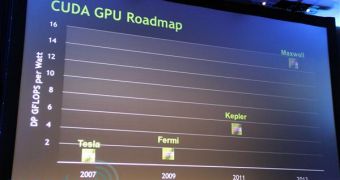Even though AMD will most certainly be the first graphics card maker to release a 28nm GPU, Nvidia hasn’t abandoned the fight and has recently disclosed that Kepler is on track and that they have already entered into the possession of the first 28nm chip samples.
“We are on track with our Kepler roadmap. We have 28nm silicon in house now,” said Igor Stanek, Senior Product PR Manager at Nvidia during an interview with the Fudzilla website.
“Our transition to 28nm is going better than 40nm, and yields are better than our original plan,” concluded the company’s rep without going into any details regarding Kepler’s roadmap.
However, over the course of the last few months, multiple Nvidia representatives have said that the first Kepler-based graphics cards aren’t expected to arrive until Q2 of 2012, so this is probably the timeline that Stanek is referring to.
Before Kepler arrives, the GPU maker is expected to release a series of die shrinks of Fermi built using TSMC's 28nm fabrication process.
The first chips based on the Kepler architecture were taped out by Nvidia at the beginning of September.
Kepler is the code name used by Nvidia to refer to its next-generation graphics processing unit architecture, which, just like AMD's Radeon HD 7000 GPUs, will be manufactured using TSMC's 28nm fabrication process.
The new graphics core is expected to be more flexible in terms of programmability than the current Fermi architecture.
In the second half of 2010, Nvidia promised that Kepler, and its successor Maxwell, will include virtual memory space (allowing both the CPU and the GPU to use a unified virtual memory) and pre-emption support, as well as a series of other technologies meant to improve the GPU's ability to process data without the help of the system's processor.
According to previous Nvidia estimates, these changes, combined with the new manufacturing process, should deliver 3 to 4 times the performance per Watt of the Fermi architecture in double-precision 64-bit floating point operations.

 14 DAY TRIAL //
14 DAY TRIAL //